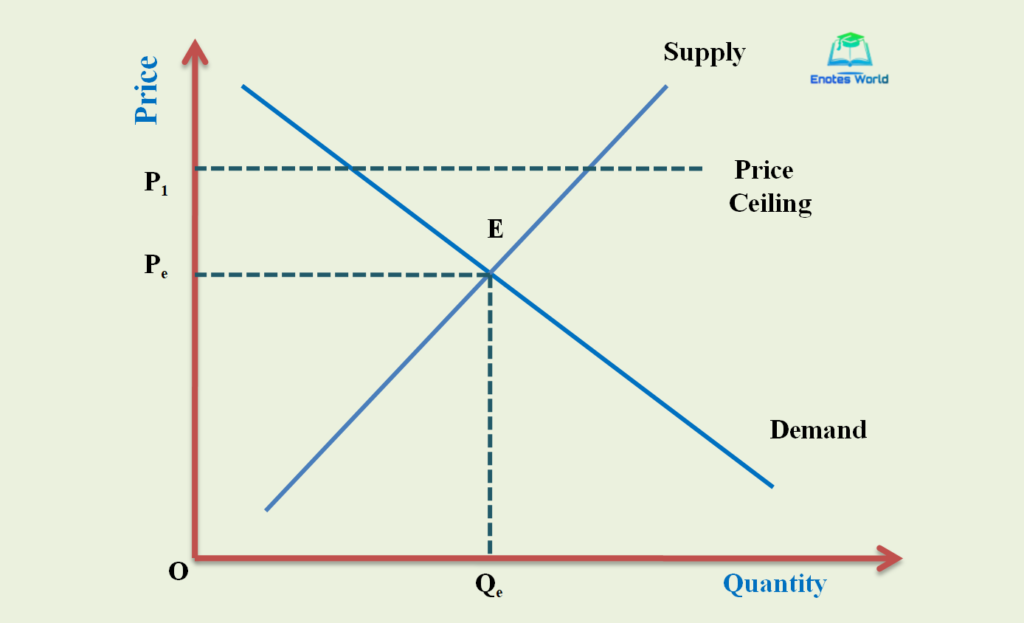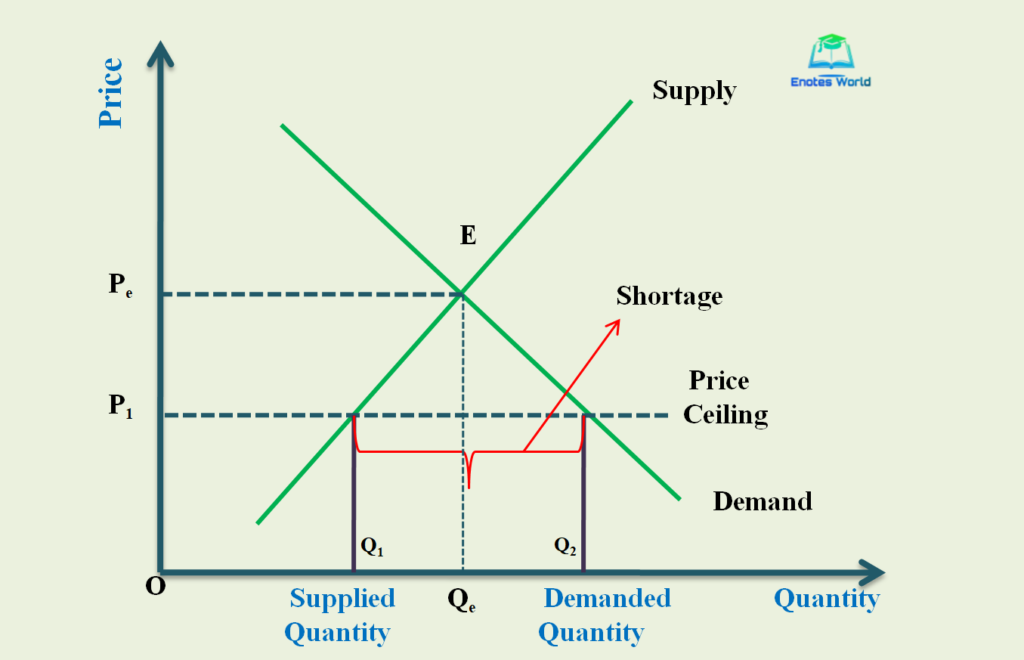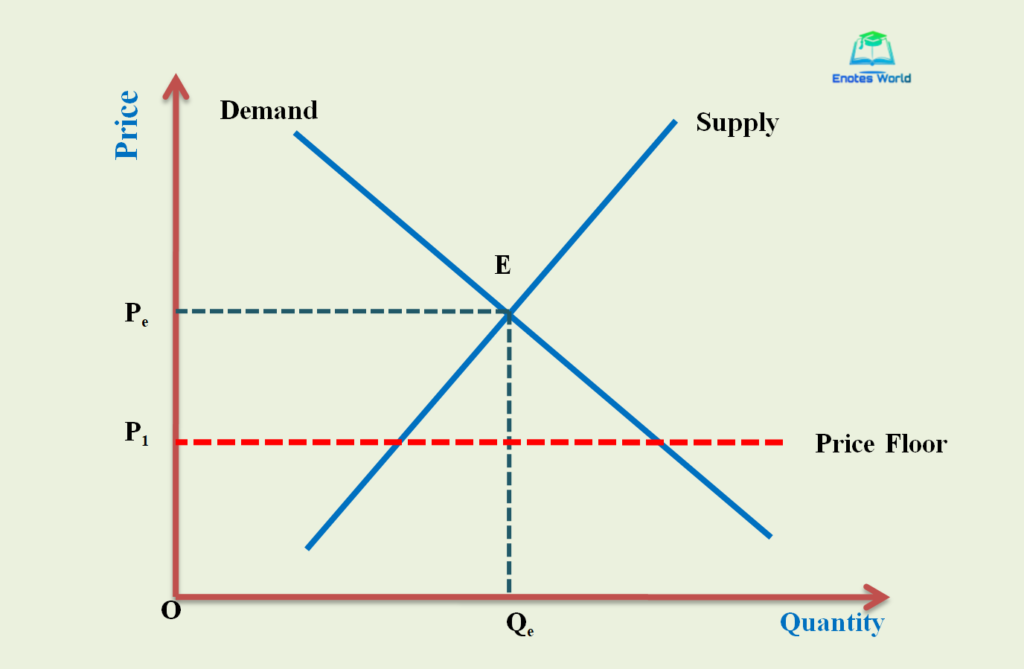If the market is free then there are no government interventions and prices and quantities adjust with the market forces of demand and supply. At the equilibrium price, the quantity that consumers are willing to buy exactly equals the quantity that sellers are ready to sell in the market. In economics, this is an efficient outcome and we assume everyone is happy with such an efficient outcome of the market. But the price determined by the market forces sometimes may be too high for a certain class of the society. And state and government as a welfare state may intervene in the market by adopting price control policies. Under the price control policy, the government may control the price using price ceiling and price floor policies. The objective of the government for implementing price control policies is to support the target groups of people living in society. Here we will discuss the price control policies of the government and their effect in market equilibrium.
Contents
Price Ceiling and Effect in Market Outcomes
The buyers of the goods and services always want to pay lower prices as much as possible. On the other hand, the sellers want to charge a possible higher price and they want to make it higher as much as possible. Their conflicting interests assemble in the free market at the equilibrium price.
However such equilibrium price for some products may be too high for a certain class of people in the community. It means even for necessary food items like rice and wheat, the equilibrium price determined by the free market may not be affordable for needy and poor people in the society. At that time the government sets a low price and the products are sold in the ration or fair price shops at the price below the equilibrium price determined by the free market. This is known as price ceiling policy and it is one of the important price control policies of the government.
A price ceiling is thus a maximum price that has fixed by the government for a particular product produced by a firm. No producers are allowed legally to charge a price higher than the price ceiling. In general, the price ceiling lies below the equilibrium price. The ceiling price or legally fixed maximum price is also known as a fair price or control price.
Due to the price ceiling of the government, the quantity demand for the goods and services exceeds quantity supply and that leads to a shortage in the market. If such a price ceiling persists in the long run, the shortage will be keener and it will invite black marketing in the economy. Whenever there are wants to fulfill because of the shortage due to legal restrictions, the emergence of black markets is almost sure. Thus, the price ceiling leads the market to inefficiency in three ways namely; an inefficient distribution of goods among buyers, wasted resources trying to buy goods and inefficiently low quality of the goods. The following figures will help to explain the concept and effect of a price ceiling in market outcomes.

The figure shows that the government imposes a price ceiling of P1 per unit of product. In such a case, the ceiling price lies above the equilibrium price of the free market. This price ceiling is Not Binding Price Ceiling. It is because that market forces of demand and supply naturally move the market to the equilibrium and price ceiling does not affect the price and quantity.

In the figure the demand and supply curve intersects with each other at point E. when there is no government policy in action then the free market price of the product is Pe and quantity is Qe. There is demand-supply equality in the market. It means and all the wants are being satisfied.
Suppose the government presumes that the price determined by the free market is too high for poor or targeted people of the society or nation. Now the government has set a price below equilibrium price as P1. This is the case of a price ceiling or Binding Price Ceiling. Now the price of the product in the market is less than the equilibrium price and as a result, consumers demand increase. So they are demanding OQ2 quantity while the producers are willing to supply less (because of lower price) equal to OQ1. Therefore, there is a shortage/demand exceeds supply in the economy by the amount of Q1Q2.
Solving the Issue of Excess Demand or Shortage
Excess demand or shortage of goods and services is an immediate outcome or implication of price ceiling or control pricing. To solve the problem of shortage, rationing is one of the probable alternatives available to the government. Through rationing the quantities, the buyers can buy only a limited quantity so that their total rationed demand is equal to Q1. Thus the government can implement its policy of rational price or fair price or control price or ceiling price through the implementation of rationing rule.
Moreover, due to the shortage, some people may always want to pay a higher price to get more than the rationed quantity. Thus there is the possibility of black marketing from the back doors means. So the price control policy of the government invariably begets a black market that otherwise would not exist.
Price Floor and Effect in Market Outcomes
The government can ensure its presence for the welfare of the poor people or targeted people in the form of another price control policy namely price floor or support price or minimum support price policy. When the government feels that the price fixes by the free market system are too low for a certain class of the people or for a certain group of individuals at that time government can implement price support or floor price policy to support them or encourage them to continue their economic activities. This policy may have designed for farmers or the agriculture sector and for workers who are unskilled and working on a daily wage basis. Like the price ceiling, the price floor is also an attempt by the government to maintain the price at other than the equilibrium level for the benefit of the people.
A price floor is a minimum price fixed by the government for a particular product produced by the firm. No producers are allowed to charge the price below the floor price. In general floor or support price lies beyond the equilibrium price. The most important example of a price floor is minimum wage legislation implemented in almost all the nations for the labor market. The following figures show the overall effect of control pricing in the market outcomes.

The figure shows that the government imposes price support of P1 per unit of the product. Here the support or floor price is below the equilibrium price or equilibrium price is above the floor price thus floor price does not work here. Thus, it is a price floor that is not binding. Market forces of demand and supply automatically drive an economy towards equilibrium.

The figure shows that market equilibrium is at point E with the intersection of demand and supply curve with equilibrium price Pe and quantity Qe. Suppose there is an implementation of support price or floor price policy from the government. Accordingly, if the government imposes the floor price of P1 lying above the equilibrium price, now at the floor price supply of the commodity exceeds demand in the market. This is the case of a price floor that is binding. At this floor quantity supplied is higher than that of demand by the amount of Q1Q2. This binding price floor has resulted in a surplus or excess supply or overproduction in the market.
Solving the Issue of Excess Supply or Surplus
The ration behind adopting the price floor by the government is to support farmers, poor’s in society. Market forces may result in the greater fluctuation of the prices of the product of farmers and that may hurt them in their well-being while selling their output in the market. Similarly, in the case of unskilled labor, they may get hurt while getting the payment of their wages if it has left on the hand of market forces of labor demand and supply. Thus the government support poor farmers and unskilled labor the price floor and minimum wage policy may implement.
But it may create or generate excess supply or output in the product market and excess supply of labor in the labor market (unemployment). The stock available in the economy over the demand is typically stored by the government. The stock of output that the government stores from the market by purchasing at floor price are buffer stock. If in a particular year or season, the production is low, the buffer stock can be released or the required quantities can be drawn from the buffer stock to meet the demand at a reasonable price.
Conclusion
The government often tries to control market prices through price ceilings and price floors. In the case of the price ceiling, the government intervenes in some markets intending to prevent prices from rising to the equilibrium price. Similarly, in the case of the price floor, the government’s goal is to intervene and maintain a price higher than the equilibrium price. The government generally adopts such price control policies to support target groups and individuals in the societies and to increase their well-being.
When the government intervenes through price ceiling and price floors in a market, the market is no longer efficient. The price ceiling creates a shortage in the economy and may also invite black marketing and illegal back door undertakings. On the other hand, floor pricing will create over-production or surplus in the economy and the government will have to accept the cost to keep floor price in implementation by purchasing the excess supply of the market. Thus the article has presented a brief discussion on the price control policies and their effect in market equilibrium.
References and Suggested Readings
Dhakal, R. (2019). Microeconomics for Business. Kathmandu: Samjhana Publication Pvt. Ltd.
Mankiw, N.G. (2009). Principles of Microeconomics. New Delhi: Centage Learning India Private Limited
Shrestha, P.P. and et.al. (2019). Microeconomics for Business. Kathmandu: Advance Sarswati Prakashan.
Hey there! Thank you for sharing your expertise on this matter. The government may find it smart to stop the increase in prices above the market equilibrium or to stop the fall in prices below the market equilibrium. Such a strategy of intervention is referred to as price control.